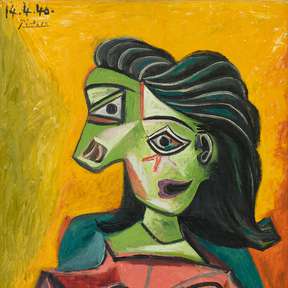In the early 60s, Richardson was planning to write a study of Picasso portraits and spent hours with the artist, studying reproductions of his works. Like Picasso, he spoke of the complexity of his pictorial thought, emphasizing, for example, that a portrait of Dora Maar may also contain elements referring to her romantic predecessor Marie-Thérèse Walter, and his successor Françoise Gilot-Richardson began to believe that a detailed biographical treatment of Picasso's portrait would fill a significant gap in Picasso scholarship. Decades later she sat down to write what would become the monumental multivolume biography, A Life of Picasso.

Maar once told Richardson that when a new woman entered Picasso's life, everything changed: the art, the house, the poetry, even the dog. Still, Maar's observation is a bit misleading, because in the era of each successive muse, Picasso never opted for a singular style. Rather, in penetrating Picasso's imagination, each woman served as a catalyst for experiments in color and form that kept shifting as the boundaries of the relationship shifted. It is through this process that Picasso's work has been constantly reinvented and renewed.
Picasso was as eclectic in his choice of muse as he was in style: the bohemian Fernande Olivier; disciplined Olga Khokhlova; blonde Venus Marie-Thérèse; passionate artists Dora and Françoise; Sylvette David, the young woman with a high ponytail; and Jacqueline Roque, the devoted, romantic beauty. Picasso's portraits of these women express psychological insights, as well as the drama that only deep intimacy can reveal. He paints everyone, as Leo Steinberg argues, not as they present themselves to the world, but as they feel inside. These women invoke poetry, beauty, war and poverty, ingeniously reflecting the spirit and reality of changing times. Not only mute muses, Fernande and Françoise have published memoirs; Olga and Marie-Thérèse kept vast archives of photographs and letters for decades; Dora gave interviews to researchers and documented Picasso's work and private life in photographs. Picasso's women are essential to our understanding of the artist and his work as they were instrumental in his creative life.
But who was sir John Patrick Richardson?
A British art historian and biographer of Picasso, he was born in London in 1924 and died in New York in 2019. From 1951 to 1962 he lived in Provence, France, where he became close friends with Picasso and his family. Richardson's multivolume A Life of Picasso (1991-) was the result of this friendship. Richardson organized six major exhibitions of Picasso's work at Gagosian. He has contributed to the New York Review of Books, The New Yorker, Burlington Magazine and Vanity Fair, and is the author of The Sorcerer's Apprentice: Picasso, Provence and Douglas Cooper (1999) and Sacred Monsters, Sacred Masters (2001). In 1993, Richardson was elected to the British Academy, and in 1995 he was appointed Slade Professor of Art at Oxford. In 2011, he was made an officer of the French Order of Arts and Letters in recognition of his contribution to the promotion of the arts in France and around the world. In 2012 he was made a Knight Commander of the Order of the British Empire (KBE) for services to the art.





